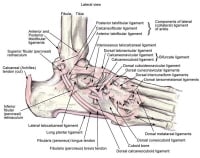The ankle joint is a hinged synovial
joint with primarily up-and-down movement (plantar flexion and
dorsiflexion). However, when the ranges of motion (ROMs) of the ankle
and subtalar joints (talocalcaneal and talocalcaneonavicular) are taken
together, the complex functions as a universal joint (see the following
image).
 Anatomy of the lateral ankle ligamentous complex and related structures. The
combined movement in the dorsiflexion and plantarflexion directions is
greater than 100°; bone-on-bone abutment beyond this range protects the
anterior and posterior ankle capsular ligaments from injury. The
anterior and posterior ankle capsular ligaments are relatively thin
compared with the medial and lateral ankle ligaments.
Anatomy of the lateral ankle ligamentous complex and related structures. The
combined movement in the dorsiflexion and plantarflexion directions is
greater than 100°; bone-on-bone abutment beyond this range protects the
anterior and posterior ankle capsular ligaments from injury. The
anterior and posterior ankle capsular ligaments are relatively thin
compared with the medial and lateral ankle ligaments.
Type I collagen tissue constitutes the bulk of the capsule and supporting ligaments of the ankle joint. The fiber density and orientation are arranged dynamically according to the typical mechanical stress experienced by the joint. Within limits, the greater the excursion of the joint capsule and ligaments, the less likely sprains are to occur; with increased motion, the muscles absorb the mechanical force energy without exceeding the tensile limits of either the joint capsule or the ligaments.
 Anatomy of the lateral ankle ligamentous complex and related structures. The
combined movement in the dorsiflexion and plantarflexion directions is
greater than 100°; bone-on-bone abutment beyond this range protects the
anterior and posterior ankle capsular ligaments from injury. The
anterior and posterior ankle capsular ligaments are relatively thin
compared with the medial and lateral ankle ligaments.
Anatomy of the lateral ankle ligamentous complex and related structures. The
combined movement in the dorsiflexion and plantarflexion directions is
greater than 100°; bone-on-bone abutment beyond this range protects the
anterior and posterior ankle capsular ligaments from injury. The
anterior and posterior ankle capsular ligaments are relatively thin
compared with the medial and lateral ankle ligaments.Type I collagen tissue constitutes the bulk of the capsule and supporting ligaments of the ankle joint. The fiber density and orientation are arranged dynamically according to the typical mechanical stress experienced by the joint. Within limits, the greater the excursion of the joint capsule and ligaments, the less likely sprains are to occur; with increased motion, the muscles absorb the mechanical force energy without exceeding the tensile limits of either the joint capsule or the ligaments.

0 التعليقات:
إرسال تعليق